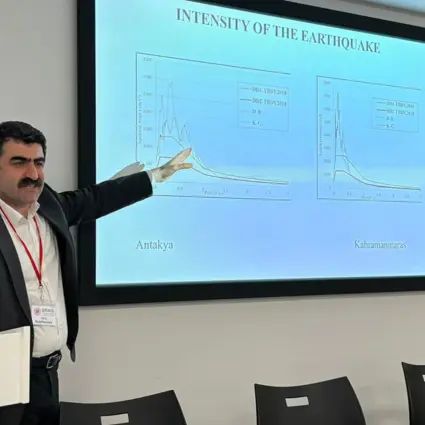Earthquakes pose a significant threat to buildings, particularly in seismically active regions. Understanding the relationship between structural properties and earthquake damage is crucial for improving building resilience and safety.
About 250 buildings were surveyed by a team of engineers and researchers from a wide consortium of organisations. The investigation aimed to determine whether structural robustness, particularly the relative cross-sectional areas of structural walls and columns, correlated with building performance during the earthquakes.
Professor Idris Bedirhanoglu, an Academic Visitor at the Department of Engineering Science, along with collaborators from the University of Canterbury, the Dicle University, the Eskisehir Osmangazi University, the Harran University, the University of Kansas and the Hacettepe University, took part in two studies to explore various reinforced concrete buildings and historic masonry structures affected by the earthquake and assess the extent of damage.
The first study was focused on the performance of reinforced concrete apartment units that were heavily damaged during the Turkey-Syria earthquakes. The team of researchers tried to find out the main reason for the total collapse and develop a simple solution to save similar apartments in case of future earthquakes.
The study, published in SAGE journals, emphasises the importance of prioritising sway control and flexibility in seismic design. It highlights the need for improved detailing to control drift effectively and suggests the use of less brittle partitions near active faults. Overall, the observed damage underscores the significance of international design practices in ensuring structural robustness against seismic events.
Prof Bedirhanoglu says, "Our observations showed that approximately 96% of structures with critical damage had wall area smaller than 0.1% of the total floor area above the ground and this value is about 0.1% for the columns as well. Engineers and contractors in regions facing seismic risk should be compelled to produce buildings with column and wall areas bigger than 0.25% of the total area of the total floor are of the building above the ground level."
In another study, researchers examined wall design and construction quality using advanced methods. These methods can help assess buildings both before and after earthquakes. Additionally, they tested the strength of the stones and mortar in the walls using non-destructive techniques.
In this study they investigated 29 historic stone masonry buildings in Hatay and Osmaniye after the 2023 Turkey earthquakes. They found that poor wall design, and poor construction quality, contributed to the damage. Non-destructive tests showed poor mortar quality, further weakening the structures. These findings could help model the behaviour of historic masonry buildings during earthquakes.
Researchers found that many stone buildings in Hatay and Osmaniye lacked walls strong enough to handle the earthquake forces, leading to collapses. While most walls were thick enough to resist shaking, 70% of the buildings had weak, crumbling masonry, making them prone to failure. Poor construction and materials contributed to this vulnerability. Tests showed wide variations in the strength of the stone and mortar used, with generally low-quality mortar.
Prof Bedirhanoglu adds, "Our studies have highlighted that current safety guidelines may be too conservative or inaccurate in certain cases, particularly with disintegrating masonry. Future research needs to consider other factors like ground structure and soil interaction to fully understand building damage."
These findings can help improve building designs and retrofitting strategies, making historic buildings more resilient to future earthquakes.
Read the full papers here:
- Quantitative evaluation of the damage to RC buildings caused by the 2023 southeast Turkey earthquake sequence: journals.sagepub.com/doi/full/10.1177/87552930231211208
- Damage to monumental masonry buildings in Hatay and Osmaniye following the 2023 Turkey earthquake sequence: The role of wall geometry, construction quality, and material properties: journals.sagepub.com/doi/abs/10.1177/87552930241247031
Illuminating the Impact of Engineering
Public Engagement with Research

